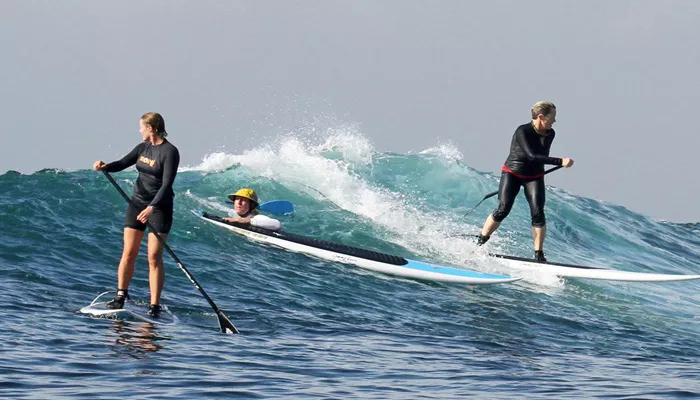Paddling is one of the most essential skills in surfing. It determines your ability to catch waves, position yourself effectively, and conserve energy throughout a session. Many surfers, from beginners to advanced riders, often overlook the importance of paddling technique, leading to fatigue, missed waves, and inefficient movement in the water. By improving your paddling, you can significantly enhance your surfing performance and endurance.
This article will provide a comprehensive guide on how to improve your paddling for surfing. We will cover key aspects such as technique, strength training, endurance exercises, board positioning, and common mistakes to avoid. Whether you’re a beginner struggling to reach the lineup or an intermediate surfer looking to increase your efficiency, these tips will help you paddle stronger, faster, and longer.
Mastering The Correct Paddling Technique
Efficient paddling begins with proper technique. Many surfers waste energy by paddling inefficiently, leading to unnecessary fatigue. Here’s how to refine your technique:
Body Positioning on the Board
Lie centered on your surfboard with your chest lifted slightly.
Avoid lying too far forward, which can cause the nose of the board to dip, or too far back, which creates drag.
Keep your feet together and relaxed to maintain a streamlined profile.
Proper Arm Movement
Use long, deep strokes rather than short, shallow ones.
Enter the water with your fingers slightly apart to increase propulsion.
Pull through the water in an S-shape motion to maximize efficiency.
Keep your elbows high during the stroke to engage your shoulders effectively.
Breathing and Rhythm
Develop a steady paddling rhythm to maintain endurance.
Breathe naturally and avoid holding your breath, which can cause tension and fatigue.
Sync your breathing with your strokes to sustain an efficient paddling pace.
Building Upper Body and Core Strength
Paddling relies heavily on upper body strength, especially in the shoulders, arms, and back. Strengthening these areas will help improve your endurance and reduce fatigue.
Key Exercises for Paddling Strength
Push-Ups – Strengthen chest, shoulders, and triceps.
Pull-Ups – Develop upper body pulling power for stronger paddle strokes.
Lat Pulldowns – Target lat muscles, essential for effective paddling.
Dumbbell Rows – Improve back and shoulder endurance.
Plank Variations – Strengthen core stability to maintain proper paddling posture.
Improving Endurance for Longer Sessions
Surfing often requires prolonged paddling periods, so improving cardiovascular endurance is crucial.
Cardiovascular Workouts for Paddling
Swimming: Mimics paddling motion and strengthens key muscle groups.
Rowing Machine: Builds endurance in the shoulders and back.
Interval Training: Short bursts of high-intensity paddling simulate the energy demands of surfing.
Long-Distance Paddling: Spend time paddling continuously to increase endurance.
Optimizing Board Position and Efficiency
Even with strong paddling technique and fitness, improper board positioning can hinder progress.
Choosing the Right Board
Larger boards provide more buoyancy and make paddling easier.
Shorter boards require more effort to paddle but allow for greater maneuverability.
Match your board to your skill level and wave conditions.
Adjusting Your Paddling Posture
Keep your chest slightly lifted to reduce drag.
Engage your core to maintain stability.
Keep movements smooth and controlled to minimize energy waste.
Common Paddling Mistakes to Avoid
Avoiding bad habits can significantly improve your paddling efficiency.
Mistakes That Reduce Speed and Endurance
Splashing too much: Creates resistance and wastes energy.
Short, frantic strokes: Less effective than long, controlled strokes.
Lack of warm-up: Increases injury risk and reduces performance.
Poor breathing technique: Leads to early fatigue.
Developing a Training Routine for Better Paddling
To improve paddling for surfing, create a structured training plan combining technique, strength, and endurance.
Sample Weekly Training Plan
Day 1: Swimming drills + push-ups + core work
Day 2: Surf session focusing on paddling technique
Day 3: Rowing machine + pull-ups + lat pulldowns
Day 4: Rest or light mobility work
Day 5: Long-distance paddling + plank variations
Day 6: Surf session + interval paddling sprints
Day 7: Rest or yoga for flexibility
Conclusion
Paddling is a fundamental skill that greatly impacts your overall surfing ability. By focusing on proper technique, building strength, increasing endurance, optimizing board position, and avoiding common mistakes, you can paddle more efficiently and enjoy longer, more productive surf sessions.
Consistently practicing these principles will help you become a stronger paddler, allowing you to catch more waves with less effort. Start incorporating these training strategies into your routine, and you’ll see significant improvements in your paddling performance.

